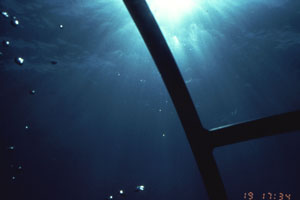Studies of Hydrothermal Processes in Crater Lake, Oregon – extracted from OSU College of Oceanography Report #90-7
Conclusions
As a result of more than three years of field studies and our interpretation of these and other data from the literature, we conclude that there are active inputs of hydrothermal fluids into the bottom of Crater Lake. The dissolved materials associated with these thermally and chemically enriched fluids, coupled with the overall hydrologic balance, control the observed chemical composition of the lake. Because the hydrothermal input dominates the flux of most dissolved chemicals into Crater Lake, the hydrothermal process is highly significant. Furthermore, the geothermal inputs have a direct effect on the density structure of the deep lake, and therefore can profoundly affect the rate of heat transport and the redistribution of dissolved salts and nutrients within the body of the lake.
 Primary funding for this project was provided by the U.S. National Park Service (Pacific NW Region, Cooperative Agreement # 9000-3-0003, subagreement #7). Additional support was provided by the OSU College of Oceanography, the OSU Foundation, the US Geological Survey, and the National Geographic Society. Other contributions to this work were made by: H. Phinney, D. McIntire, G. Larson, M. Buktenica, Oregon State University; C. R. Bacon, C. H. Nelson, J. H. Barber, Jr., U.S.G.S.; D. Karl, U. Hawaii; J. Lupton, NOAA PMEL; M. Watwood, C. Dahm, U. of New Mexico; A. Soutar, R. Weiss, U. C. San Diego; C. G. Wheat, MBAR
Primary funding for this project was provided by the U.S. National Park Service (Pacific NW Region, Cooperative Agreement # 9000-3-0003, subagreement #7). Additional support was provided by the OSU College of Oceanography, the OSU Foundation, the US Geological Survey, and the National Geographic Society. Other contributions to this work were made by: H. Phinney, D. McIntire, G. Larson, M. Buktenica, Oregon State University; C. R. Bacon, C. H. Nelson, J. H. Barber, Jr., U.S.G.S.; D. Karl, U. Hawaii; J. Lupton, NOAA PMEL; M. Watwood, C. Dahm, U. of New Mexico; A. Soutar, R. Weiss, U. C. San Diego; C. G. Wheat, MBAR
Other pages in this section
*** previous title *** --- *** next title ***

